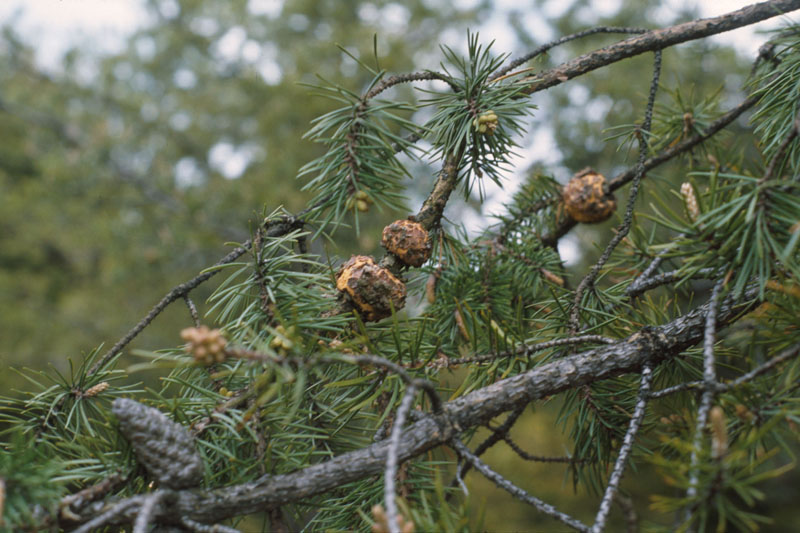Introduction
Pine-pine gall rust, also referred to as western gall rust, and Woodgate gall rust, is a fungal disease that infects two and three needle pine trees. It is caused by the fungus, Endocronartium harknessii. Pine-pine gall rust is similar to pine-oak gall rust, though it does not require an alternate host to complete its disease cycle. Instead, the fungus is spread between susceptible pine trees. Pine-pine gall rust can rapidly infect individual branches, or trees. Galls that develop on the main stem of a tree can severely disfigure, or kill the host.
Distribution & Habitat
Pine-pine gall rust occurs throughout the United States. It is most prevalent throughout the Western and Mid-Western states.
Hosts
Scots pine and Jack pine are the two most common hosts. Many other pines, such as Austrian, ponderosa, lodgepole, western yellow, and mugo pine, have also been reported as hosts.
Disease Cycle
The fungus overwinters in the vascular cambium of infected pine trees. The presence of the fungus in the vascular cambium promotes rapid cellular growth in the tissue, causing a gall to form. Galls develop for two to four years, becoming increasingly enlarged. During this period, blister-like fruiting bodies, called aecia, form on the gall surface. Once the galls have reached maturity, the gall epidermis splits open, and releases powdery yellow-orange spores, which are disseminated to nearby pine trees, where they initiate new infections. Depending on the geographic location, sporulation may occur from early to late spring. Following infection, minute swellings may begin to develop on branches where the new galls are forming.
Symptoms of Infection
Pine-pine gall rust causes the formation of woody galls on the branches and stems of infected pines. The galls typically remain relatively small, resembling golfballs when mature. Some may grow as large as grapefruits, or pomegranates. New infections generally occur on vigorous shoots. Infections are difficult to detect for the first six months. The galls enlarge over two to four years, becoming increasingly spherical, or rounded. Galls may become large enough to girdle, and kill the infected branch. If a gall forms on the main stem, it may disrupt the tree’s vascular system, preventing the distribution of water and nutrients throughout the crown. This often culminates in tree mortality. Numerous galls may form on an individual branch, causing it to develop a malformed appearance. One to two years after infection, small swelling growths may develop on infected branches. On heavily infected branches, needles may turn yellow, and then brown. Infected branches may die back prior to sporulation.
Management
- When galls are discovered on a landscape tree, excise the diseased branches. Pruning cuts should be administered in late winter or early spring, prior to sporulation.
- When pruning, remove dead branches from the tree to improve air circulation, and increase tree vigor.
- A registered fungicide may be applied to trees in early spring, before the galls produce spores.
- Maintain tree vigor through sound cultural practices. Ensure that trees are sufficiently watered, especially during extended periods of drought. Apply a layer of organic mulch around the base to improve soil quality, moderate soil temperature, and maintain soil moisture.
Photo courtesy of the Government of Canada


